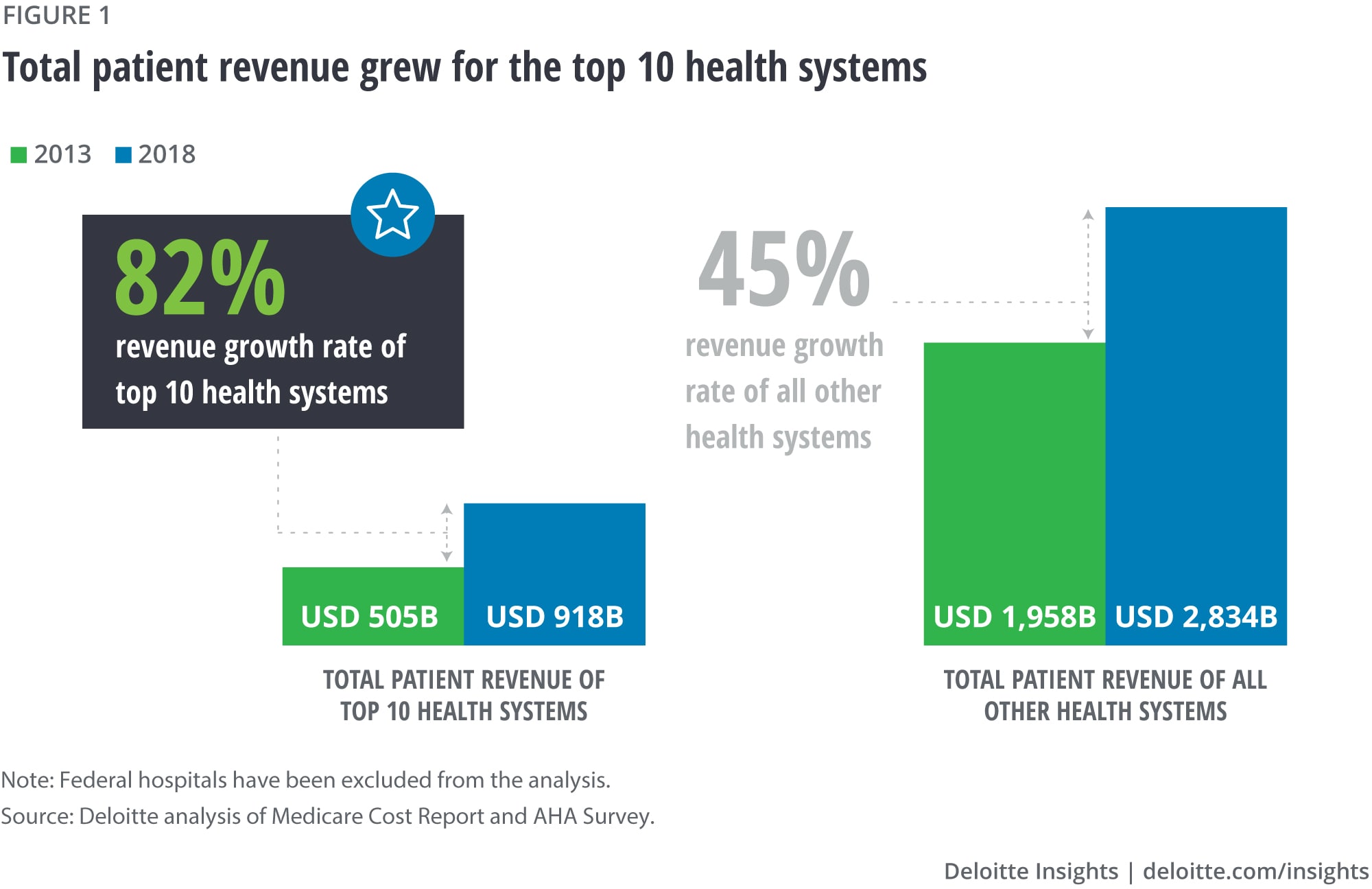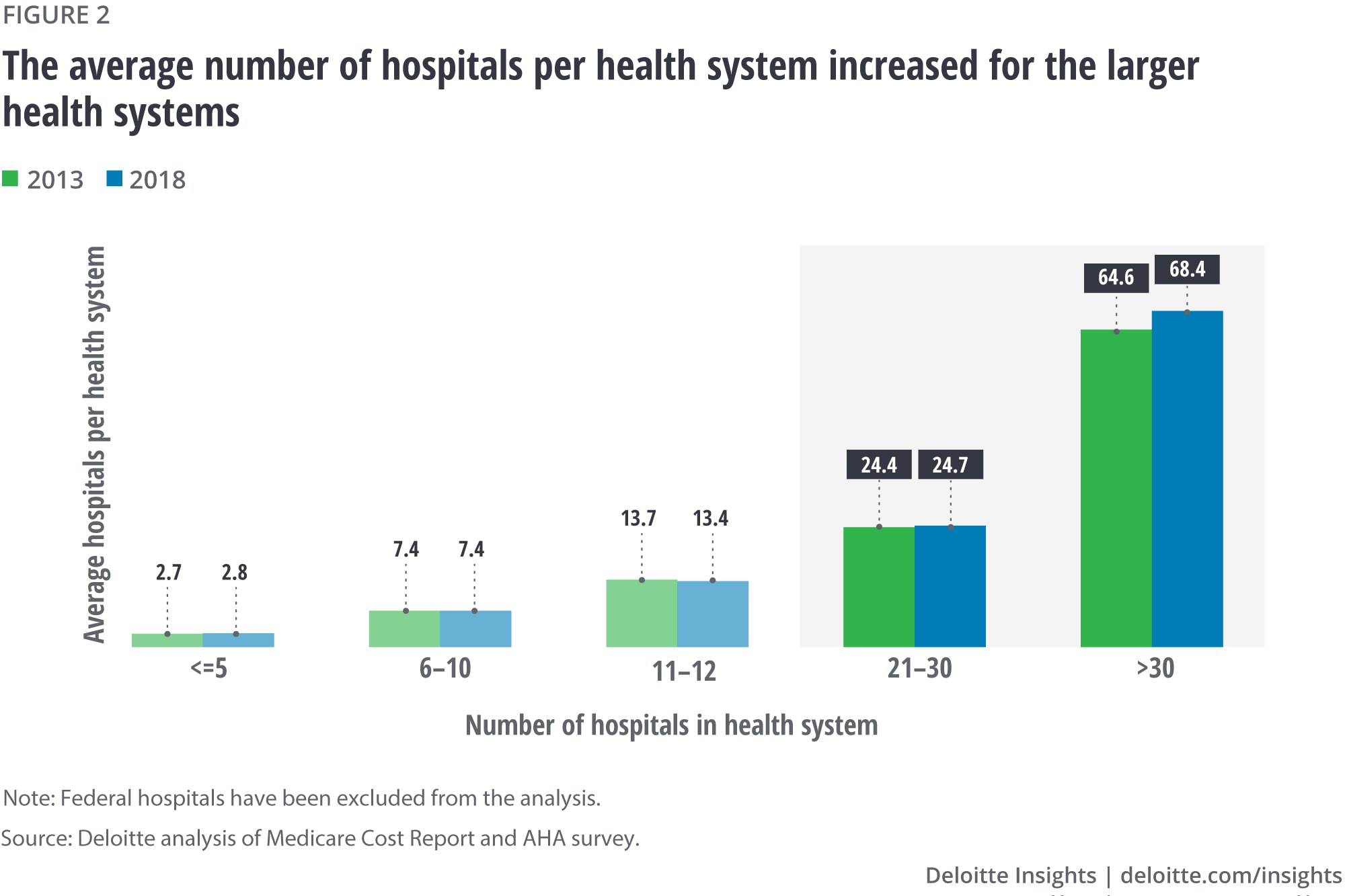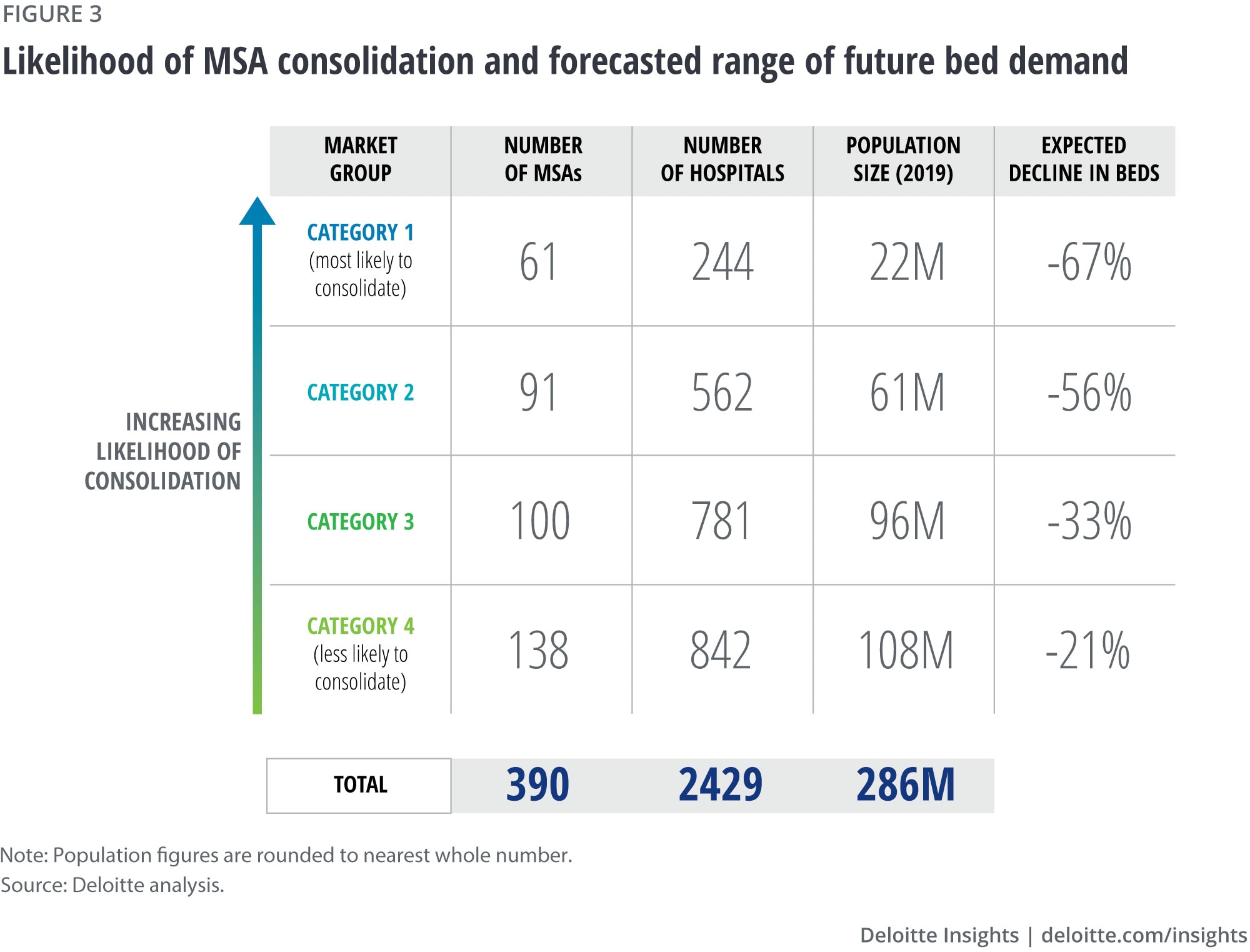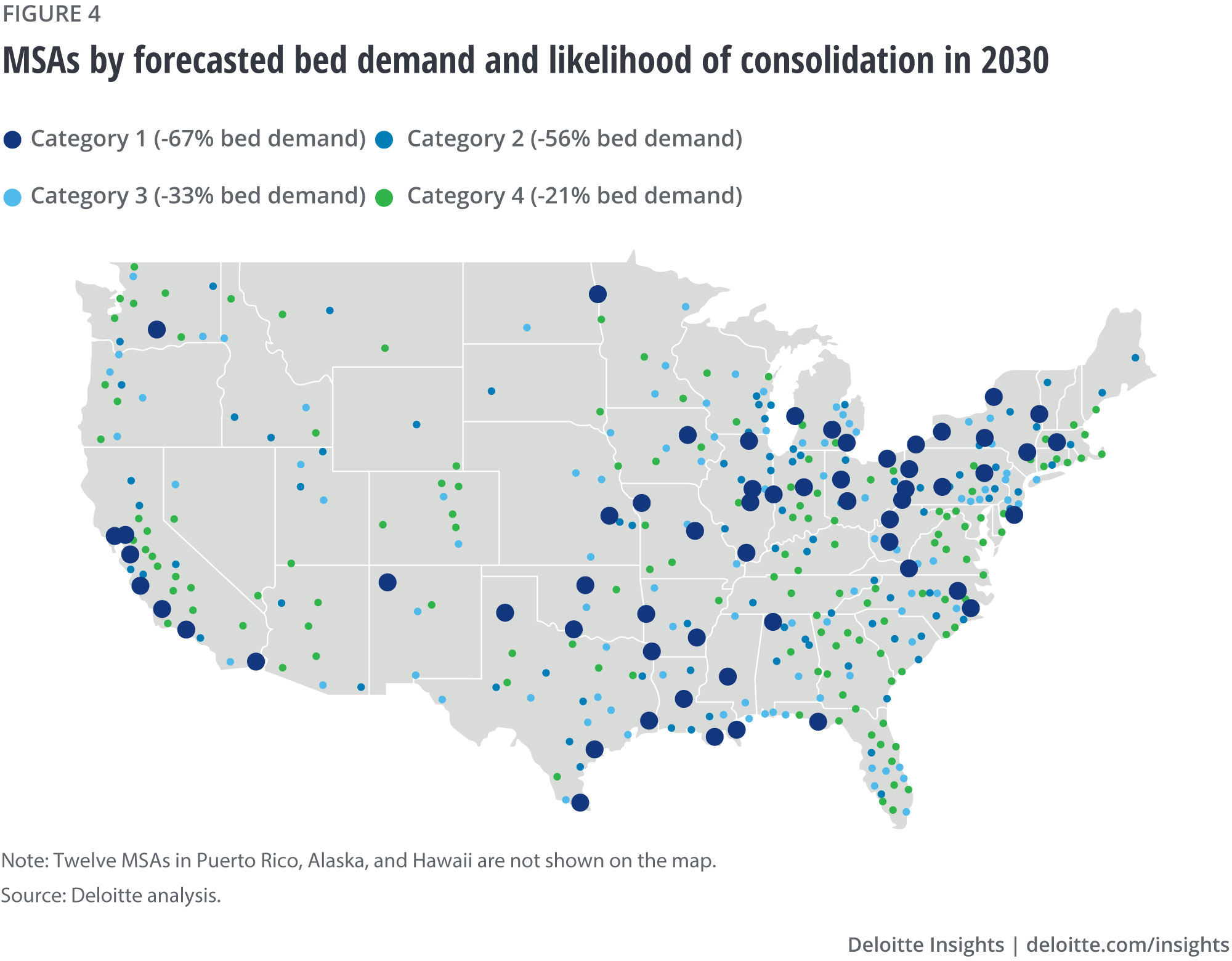
The potential for rapid consolidation of health systems How can hospitals use M&A to innovate for the future?
9 minute read
10 December 2020
 Traci Prevost United States
Traci Prevost United States.jpg) Ion Skillrud United States
Ion Skillrud United States Wendy Gerhardt United States
Wendy Gerhardt United States Debanshu Mukherjee United States
Debanshu Mukherjee United States
Rapid consolidation of health systems will likely continue due to financial pressures, growth of nonhospital care settings, and the need for transformed care delivery. Discover how health systems can strategically use M&A to innovate.
Executive summary
In 2014 through an analysis of hospital M&A trends, we predicted the rapid consolidation of health systems over the following 10 years due to regulatory, technology, and market dynamics. We estimated that by 2024, only 50% of health systems would remain and independent hospitals would no longer exist. Much has happened since then.
- Where were we right? Hospital consolidation continued in the past five years. The top 10 health systems now control 24% market share and their revenue grew at twice the rate of the rest of the market.
- Where were we wrong? Consolidation was a bit slower than our original predictions. Some hospitals in rural and suburban settings continue to exist independently.
- Where do we go from here? The industry has been on a trajectory toward more virtual care and fewer hospital beds, and the COVID-19 pandemic accelerated those care delivery trends. Health systems with their business and revenue focused on hospital care should transform their business models toward a broader portfolio of noninpatient care delivery and other revenue generating business offerings. We believe that M&A is likely given the imperative for organizations to innovate through new capabilities, resources, and relationships. For these new reasons, we stick with our prediction: rapid consolidation of health systems.
Learn more
Explore the health care collection
Learn about Deloitte’s services
Go straight to smart. Get the Deloitte Insights app.
Considering where the industry is now heading, we updated our original modeling in 2020 based on analysis of the latest trends and data. Compared to today, in 2030, we expect:
- Inpatient hospital revenue will be 35% lower.
- The demand for hospital beds will be 44% lower (our median estimate), meaning hospitals will be smaller and there will be fewer hospitals.
Our new forecast predicts that hospital M&A will likely occur in nearly every market, some to consolidate toward a more focused care delivery model and others, for survival:
- Of the 390 metropolitan statistical areas (MSAs) across the United States, 61 are most likely to see consolidation based on our forecasted 67% lower demand for hospitals beds in their MSA.
- Hospitals in the other 329 MSAs are also likely to consolidate, though perhaps to a lesser degree; we predict demand for beds in these areas will decline between 21% and 56%.
Health systems should consider how they can control their own destiny and innovate care delivery with an eye toward longer term business model transformation by:
- Determining an optimal asset portfolio that aligns with the market’s shift toward care delivery away from hospitals and supports the organization’s long-term strategy
- Developing a buy, build, partner analysis to fill in gaps to gain new capabilities, including non-inpatient care delivery services and nonhealth care revenue generating businesses
- Maximizing and fully integrating the organization’s current assets, including legacy acquisitions
One can never accurately predict what may happen in a decade; however, transformation of care delivery models and, therefore, hospital consolidation will likely continue.
Methodology
To understand past hospital M&A trends and forecast future expected consolidation, the Deloitte Center for Health Solutions analyzed multiple databases and trends at both the hospital and MSA level. More details on assumptions are discussed later in the paper. Our high-level methodology included:
- Analysis of M&A trends from the Medicare cost report and Irving Levin databases, 2014–2018.
- Inpatient hospital revenue forecasted based upon the National Health Expenditure (NHE) projections from CMS for 2019 to 2027 (which takes population trends into account), analysis of the financial impact of the COVID-19 pandemic on hospital volume and financial performance, and extrapolation of hospital volume trends from 2011 to 2018.
- Bed demand for 2030 forecasted using these revenue projections and assumptions driven by market trends for revenue per admission, length of stay, and utilization.
- MSA-level bed demand and M&A levels forecasted by analysis of past hospital performance and utilization trends from 2016 to 2018, and demographic trends (MSA-level population expected growth).
Looking back: What happened in the past five years?
The industry has consolidated much since 2014, in pursuit of cost efficiencies through scale and improved market position for value-based care. Independent hospitals combining with other independents and mid-sized systems in their local market drove some of the M&A in the sector. But much of the change in the health system landscape was due to mid-sized and large health systems merging with each other across the country, resulting in fewer independent hospitals and larger health systems. The industry also experienced a shift in care away from the hospital toward more outpatient and virtual care delivery during this period due to technological advances in clinical procedures and growing pressure to treat patients in lower cost settings. These trends—particularly the use of virtual care—were accelerated by the COVID-19 pandemic.
The 10 largest health systems grew significantly in market share and revenue. Between 2012 and 2018, the market share (based on patient revenue) of the 10 largest health systems grew to be nearly a quarter of the market. This is due to growth in both revenue and consolidation. Revenue grew for the 10 largest health systems nearly twice as much during this period compared with the rest of the health systems and independent hospitals in the market (82% vs. 45%).

Health systems are larger. While the total average number of hospitals per health system increased slightly (from 6.4 in 2013 to 6.5 in 2018), the larger systems got even bigger. The largest health systems (those with more than 30 hospitals) saw their average number of hospitals increase the most among all the health system size cohorts (figure 2).

Source: Deloitte analysis of Medicare Cost Report data. Federal hospitals were excluded from the analysis.
More care shifted away from the hospital. Advances in clinical technology continued to allow more types of care to be safely provided outside of a hospital. Outpatient and other alternative care settings became even more popular in the past five years with consumers and payers due to their convenience, lower cost, and better value. Outpatient care now makes up a larger portion of hospitals’ revenue.
- Outpatient care grew from 28% to 48% of overall hospital revenue between 1994 and 2018.1
- Between 2011 and 2018, hospital outpatient revenue grew at a higher compounded annual rate (9%) compared to inpatient revenue (6%).2
Looking forward: What will happen in the next 10 years?
What we didn’t accurately predict five years ago was the level of acceleration of the shift in care away from the hospital. The adoption of virtual health accelerated dramatically during the COVID-19 pandemic.3 Greater scrutiny of disparities in care can also transform how hospitals will operate in the future with more focus on improving the health of those in the health systems’ communities with the consumer and equity at the center of efforts.4 The increasing presence of and opportunities for outside entrants and disrupters to the industry are a growing threat to incumbents.5 These trends are expected to result in care delivery becoming more virtual, prevention/well-being–focused, consumer-centric, and equitable. What does this mean for hospitals today and how does this lead to M&A?
Fewer hospitals will likely be needed in 2030 leading to the rapid consolidation of health systems. We expect these trends to lead to a drop in demand for inpatient beds over the next 10 years with commensurate lower inpatient hospital revenue and demand for fewer hospitals, resulting in continued significant consolidation among hospitals and health systems during the period.
We forecast that at the national level, inpatient hospital revenue will be 35% lower and demand for hospital beds will be 44% lower (our median estimate) than today. Fewer beds mean fewer and smaller-sized hospitals. In our vision for the future of health, hospitals will be smaller and much more specialized.6 (See Appendix for more details on methodology.)
Health systems will likely be confronted with significantly lower revenue and decisions about where care can and should be delivered. Care in hospitals will likely become much more specialized. Those looking to innovate will seek consolidation to gain more capabilities, resources, and relationships. We believe that M&A is likely given the imperative for companies to compete in this changing world, the entry of disrupters, and the broader push for care to be delivered in a more equitable, preventive, and well-being–focused manner. All of the M&A tools—mergers, acquisitions, integration, and divestures—can help organizations innovate in the future. Some organizations will seek M&A to develop a broader portfolio of care delivery options and nonhealth care businesses. Others may end up seeking consolidation to survive. Either way, M&A is a leading strategy to create opportunities for relationships, capabilities, and services.
M&A activity during the next 10 years will vary by market. We expect to see hospital M&A in all geographic areas due to the forecasted significant decline in inpatient hospital revenue and beds. However, it will likely be most pronounced in MSAs in markets with declining or flat population growth and hospitals with poor financial performance.
To project likelihood of M&A by specific market, we categorized all 390 MSAs based on the performance of the hospitals in the market and demographic factors (figures 3 and 4). The categories that we developed—numbered 1 (most likely to consolidate) to 4 (least likely to consolidate)—include MSAs across the country sharing similar traits that will likely lead to health system M&A (see sidebar, “Methodology,” for more details).


What does this mean for health systems that are considering M&A?
Health systems should consider how they can leverage the tools of M&A—acquisitions, mergers, integration, and divestures—to transform themselves, innovate care delivery, and succeed in the future.
The demand for fewer beds, but also the need to gain new capabilities, may require innovation in care delivery and thinking differently about how to approach M&A. In the past, M&A was about scale. But with care trends shifting care delivery toward a more consumer-centric, equitable, well-being, and prevention-oriented approach, now health systems should be smarter about their strategies, asset portfolios, and capabilities. With an eye toward the future, they should focus their strategy on using M&A to innovate through new relationships, capabilities, and services.
Executives should consider the following approach to position their organization for the future:
- Determine an optimal asset portfolio. The portfolio should align with the organization’s long-term strategy and trends. This will mean organizations will need a broader portfolio of noninpatient care services—the right mix of hospitals, outpatient, virtual health, and other care delivery settings that will ensure equity, prevention, and well-being in its community. Settings such as postacute and behavioral health should also be part of the portfolio discussions to move the organization toward broader services, and even nonhealth care businesses should be considered.
- Develop a buy, build, partner analysis to fill in gaps. Organizations should identify gaps in their current asset portfolio and create a plan to build, acquire, or merge. This can enable innovative ways to gain new capabilities or reach new markets or geographies. Partnerships with technology companies, disrupters, and others in the community may all help develop innovative care delivery models or nonhealth care services and capabilities that an organization could not have done on its own. Divestitures may also be an important tool.
- Maximize and integrate the organization’s current assets. Current assets should be aligned for technology, culture, branding, leadership, and clinical delivery. Legacy acquisitions or newly built assets should be reassessed to ensure alignment. Divestitures, shuttering, and repurposing assets are also options to consider.
With rapid consolidation expected in nearly every market and to control one’s own destiny, health systems should start strategic planning immediately to position for success in the future.
The pandemic might have been unprecedented in its impact but even as we set out on the road to recovery, we expect change to be a constant in the health care industry. Care delivery is changing. Hospital business models are changing. The concept of scale is changing. Executives should be smart about how they get there.
Appendix
Assumptions for revenue projections:
- In 2018, Deloitte came up with its vision for the future of health that predicts a shift in care from inpatient to virtual, outpatient, and alternative settings.
- We calculated future hospital inpatient revenue, starting with the NHE publicly available projections published by the CMS Office of the Actuary. These take population trends into account.
- Using the NHE projected average growth rate between 2019 and 2027 (5.4%), the negative financial impact of the pandemic on hospital performance,7 and extrapolating past care delivery trends (shifting away from inpatient hospitals toward outpatient, virtual, and other settings);8 we estimated inpatient hospital revenue through 2030.
Assumptions for bed demand: High, medium, and low scenarios for each of the following assumptions based upon 2014–2018 national hospital trends from the Medicare cost report and assumptions based on historic performance and our future of health vision.
- Average revenue per admission will increase since hospitals will address complex patients who need critical care.
- Average length of stay for patients will remain flat due to use of data and advanced technologies to treat patients.
- Utilization across hospitals will improve to align with those of leading organizations.
Assumptions for MSA-level analysis:
- We analyzed the population trend (2018–2019) by MSA using the US Census Bureau data and the financial performance and utilization data for each hospital in the MSA using the Medicare cost report (2016–2018).
- We then applied the national projections for inpatient hospital revenue and bed decline to each MSA.
- Using these parameters, we categorized each MSA into four groups based on forecasted bed demand and subsequent likelihood of consolidation.
- MSAs in category 1 are those with the largest expected decline in beds and highest likelihood of M&A. They have a declining or flat population trend and a portion of their hospitals with poor financial performance and low bed utilization (though not all).
- MSAs in category 4 are those with lowest expected decline in hospital beds and lower likelihood of M&A. They have an increasing population trend and a larger portion of their hospitals with strong financial performance and high bed utilization.
© 2021. See Terms of Use for more information.
More in health care
-
Understanding human behavior in designing a future of health Article4 years ago
-
Equipping physicians for value-based care Article4 years ago
-
The future of work in health and human services Article4 years ago
-
Loss of health insurance from the pandemic Article4 years ago
-
Are consumers already living the future of health? Article4 years ago








.jpg/_jcr_content/renditions/cq5dam.web.231.231.desktop.jpeg)

